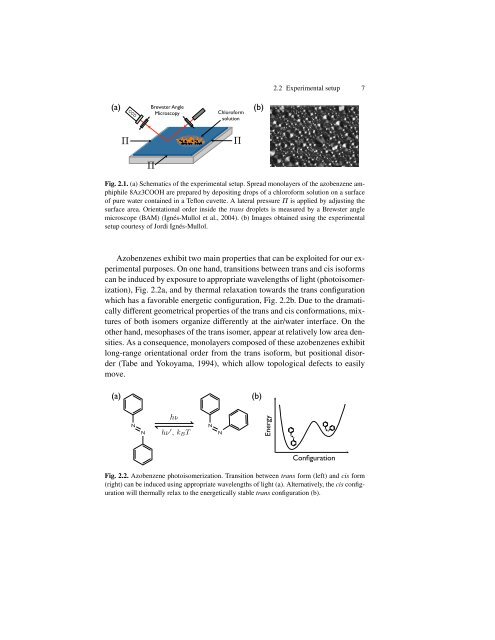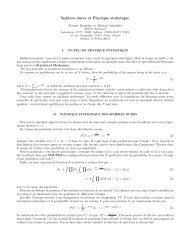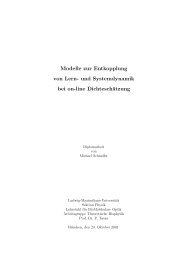Thesis (pdf) - Espci
Thesis (pdf) - Espci
Thesis (pdf) - Espci
Create successful ePaper yourself
Turn your PDF publications into a flip-book with our unique Google optimized e-Paper software.
(a) (b)<br />
Π<br />
CCD CCD<br />
Brewster Angle<br />
Microscopy<br />
Π<br />
Chloroform<br />
solution<br />
Π<br />
2.2 Experimental setup 7<br />
Fig. 2.1. (a) Schematics of the experimental setup. Spread monolayers of the azobenzene amphiphile<br />
8Az3COOH are prepared by depositing drops of a chloroform solution on a surface<br />
of pure water contained in a Teflon cuvette. A lateral pressure Π is applied by adjusting the<br />
surface area. Orientational order inside the trans droplets is measured by a Brewster angle<br />
microscope (BAM) (Ignés-Mullol et al., 2004). (b) Images obtained using the experimental<br />
setup courtesy of Jordi Ignés-Mullol.<br />
Azobenzenes exhibit two main properties that can be exploited for our experimental<br />
purposes. On one hand, transitions between trans and cis isoforms<br />
can be induced by exposure to appropriate wavelengths of light (photoisomerization),<br />
Fig. 2.2a, and by thermal relaxation towards the trans configuration<br />
which has a favorable energetic configuration, Fig. 2.2b. Due to the dramatically<br />
different geometrical properties of the trans and cis conformations, mixtures<br />
of both isomers organize differently at the air/water interface. On the<br />
other hand, mesophases of the trans isomer, appear at relatively low area densities.<br />
As a consequence, monolayers composed of these azobenzenes exhibit<br />
long-range orientational order from the trans isoform, but positional disorder<br />
(Tabe and Yokoyama, 1994), which allow topological defects to easily<br />
move.<br />
(a) (b)<br />
N<br />
N<br />
hν<br />
Energy<br />
N<br />
hν kBT<br />
N<br />
′ , N<br />
N<br />
N N<br />
Configuration<br />
Fig. 2.2. Azobenzene photoisomerization. Transition between trans form (left) and cis form<br />
(right) can be induced using appropriate wavelengths of light (a). Alternatively, the cis configuration<br />
will thermally relax to the energetically stable trans configuration (b).




